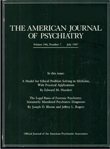Correlation between reduced in vivo benzodiazepine receptor binding and severity of psychotic symptoms in schizophrenia [published erratum appears in Am J Psychiatry 1997 May;154(5):722]
Abstract
OBJECTIVE: Although there is evidence from postmortem studies suggestive of deficient inhibitory neurotransmission of gamma- aminobutyric acid (GABA) in schizophrenia, no direct in vivo evidence has been obtained to date. The authors used single photon emission computed tomography (SPECT) with iodine-123-labeled iomazenil ([123I]iomazenil), a radioligand that selectively binds with high affinity to the benzodiazepine subunit of the GABAA receptor complex in the human brain, to investigate the presence of benzodiazepine receptor abnormalities in the cerebral cortex of living subjects with schizophrenia. METHOD: Dynamic [123I]iomazenil SPECT was performed in 15 patients (14 patients with DSM-III-R schizophrenia and one with schizophreniform disorder) and 12 healthy subjects over a period of 2 hours. The time-integral method was used to generate ratios of "specific" to "nonspecific" [123I]iomazenil binding at equilibrium for several cortical regions. RESULTS: No overall between-group differences in benzodiazepine receptor binding were found, but significant correlations emerged between the severity of schizophrenic symptoms and [123I]iomazenil binding in limbic cortical regions: positive symptom scores were negatively correlated with benzodiazepine receptor binding in the left medial temporal region, and negative symptoms were inversely related to receptor binding in the medial frontal region. These correlations were not significant when a Bonferroni correction for multiple comparisons was applied. CONCLUSIONS: These preliminary results are consistent with previous research implicating limbic cortical regions in the pathophysiology of schizophrenia, suggesting that reduced inhibitory GABAergic tone in these areas may contribute to the appearance of schizophrenic symptoms.



